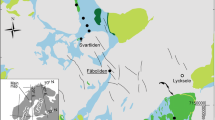Abstract
Fluid inclusions provide the only direct samples of palaeofluids that may be related to mineralisation processes. In order to apply fluid inclusion data to study fluid flow on a larger scale, we have used a mineral systems approach, which regards a mineral deposit as part of a much larger system and considers all the processes that are involved in mobilising ore components from a source, transporting and accumulating them in a more concentrated form and then preserving them throughout the subsequent geological history. This not only enables a better understanding of fluid flow processes but also enables fluid inclusions to provide an exploration target that is much larger than the ore deposit itself.
As an example, a study of fluid inclusions associated with gold mineralisation in the Tanami Region of Northern Australia was used to determine the temperatures and compositions of the ore fluids. Once the parameters of the mineralising fluids were established, the study was then expanded to a region of central Australia covering almost 100,000 km2. It was concluded that a high temperature (320–360 °C), low salinity fluid containing CO2 and other gases was circulating in the northern part of this region at around 1720 Ma. This suggests the circulation of an orogenic gold style fluid and indicates that this region has potential for other orogenic gold deposits. In the southern part of this region, a lower temperature (120 to 190 °C), high salinity fluid with no detectable gases was present and appears to represent circulation of a basinal brine.
In the second example, fluid inclusion data from Cu-U-Au- Ag-REE prospects in the Olympic Copper-Gold Province in South Australia were used to constrain geochemical modelling of the mineralisation processes. By combining the inversion-generated, 3-D geophysical maps with geochemical and magnetic susceptibility values derived from the modelling, it has been possible to divide the range of observed magnetic susceptibilities into divisions that represent the various alteration assemblages within this region. This approach allows us to use geochemical modelling to relate alteration assemblages, and hence, the predicted sites of mineralisation, to the geophysical expressions of the mineral deposit.
Similar content being viewed by others
References
Ahmad, M., Vandenberg, L.C. and Wygralak, A.S. (2013) Chapter 11: Tanami Region. In: Ahmad, M. and Munson, T.J. (compilers). ‘Geology and Mineral Resources of the Northern Territory’. Spec. Publ., no.5, Northern Territory Geological Survey, pp. 11:1–11:41.
Bagas, L., Huston, D.L., Anderson, J. and Mernagh, T.P. (2007) Palaeoproterozoic gold deposits in the Bald Hill and Coyote areas, Western Tanami, Western Australia. Mineralium Deposita, v.42, pp.127–144.
Baggott, M., Schmeider, S. and Robinson, C. (2016) Exploration success and resource growth at Newmont’s Tanami Operations, Northern Territory. (unpubld.).
Bastrakov, E.N., Skirrow, R.G. and Davidson, G.J. (2007) Fluid Evolution and Origins of Iron Oxide Cu-Au Prospects in the Olympic Dam District, Gawler Craton, South Australia. Econ. Geol., v.102, pp.1415–1440.
Fraser, G. (2002) Geochronology of Tanami ores and host rocks. Northern Territory Geological Survey. Northern Territory Geological Survey Record 2002/0003 Knox
Robinson, C.M. and Wyborn, L.A.I. (1997) Towards a holistic exploration strategy: Using Geographic Information Systems as a tool to enhance exploration. Australian Jour. Earth Sci., v.44, pp.453–463
Lane, R. and Guillen, A. (2005) GIS and Spatial Analysis, Geologically-inspired Constraints for a Potential Field Litho-inversion Scheme (unpubl.).
Mernagh, T.P. and Wygralak, A.S. (2007) Gold ore-forming fluids of the Tanami region, Northern Australia. Mineralium Deposita, v.42, pp.145–173.
Scrimgeour, I.R. (2013) Aileron Province. In: Ahmad, M. and Munson, T.J. (Eds.), Geology and Mineral Resources of the Northern Territory, Spec. Publ., no.5, pp.12:11–12:74. Northern Territory Geological Survey, Darwin.
Wyborn, L.A.I., Heinrich, C.A. and Jaques, A.L. (1994) Australian proterozoic mineral systems: essential components and mappable criteria. Australasian Inst. Min. Metal. Publ. Series, no.5/94, pp.109–115.
Williams, N. and Skirrow, R. (2004) The low down on Gawler copper gold. AusGeo News, v.74, pp.4–5.
Wygralak, A.S. and Bajwahl, Z.U. (1998) Geology and mineralisation of the Arunta Inlier, Northern Territory. AGSO Jour. Australian Geol. Geophys., v.17, pp.35–45.
Author information
Authors and Affiliations
Corresponding author
Rights and permissions
About this article
Cite this article
Mernagh, T.P., Wygralak, A. & Bastrakov, E. The relevance of fluid inclusions to mineral systems and ore deposit exploration. J Geol Soc India 90, 531–537 (2017). https://doi.org/10.1007/s12594-017-0749-x
Published:
Issue Date:
DOI: https://doi.org/10.1007/s12594-017-0749-x




